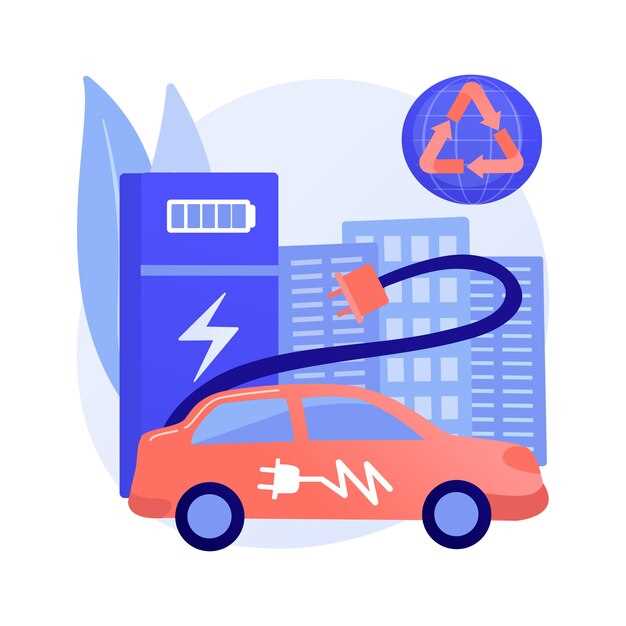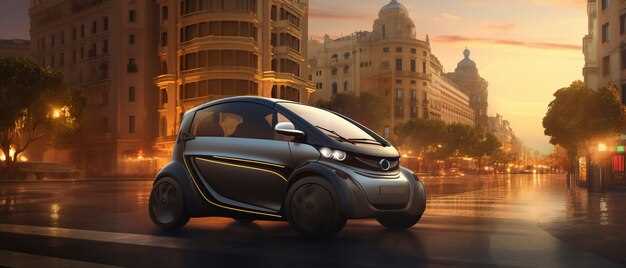Optimize your electric vehicle’s performance by understanding the critical role of batteries. The choice of battery significantly influences driving range, acceleration, and charging time. Selecting a lithium-ion battery with higher energy density can boost your EV’s mileage, allowing for longer journeys without frequent stops. For instance, Tesla’s use of 2170 cells enables impressive range estimates, making them a leader in performance.
Pay attention to battery management systems (BMS). A robust BMS enhances the longevity and efficiency of your battery, ensuring optimal conditions during operation. Systems that monitor temperature and charge cycles prevent overcharging and overheating, which can damage battery life. Brands like Nissan have integrated smart BMS technology to maximize the lifespan of their battery packs by adjusting performance based on real-time data.
Charging infrastructure also plays a significant role. Opt for EVs compatible with fast charging stations to minimize downtime on long trips. Many new models support ultra-rapid charging, providing substantial range in just a few minutes. The latest advancements in charging technology can recharge batteries to 80% in under 30 minutes, allowing you to get back on the road quickly.
Lastly, regularly check battery health using manufacturer-provided diagnostics. This proactive approach identifies potential issues, ensuring that your vehicle performs at its best. Understanding these aspects can significantly enhance your electric vehicle experience, providing both reliability and efficiency on the road.
Battery Capacity and Vehicle Range: What to Expect
Expect electric vehicles (EVs) with higher battery capacity to deliver extended ranges, often exceeding 300 miles on a single charge. For instance, battery packs ranging from 60 kWh to 100 kWh typically provide the best performance.
- A 60 kWh battery generally offers a range of about 200-250 miles.
- 75 kWh batteries can achieve up to 270-320 miles.
- With 100 kWh batteries, you can expect ranges of 300-400 miles, depending on the vehicle’s efficiency.
Understanding the efficiency of the vehicle is also key. Factors such as aerodynamics, weight, and tire efficiency directly affect the overall range. Lighter vehicles with streamlined designs tend to utilize battery capacity more effectively.
Weather conditions play an influential role. Cold temperatures can reduce battery performance, leading to a 20-30% decrease in range. Planning charging strategies during extreme weather can help offset this impact.
Battery care impacts longevity and performance. Regular charging, maintaining appropriate charge levels, and avoiding complete discharges can ensure that your investment performs optimally over time. Aim to keep the battery charge between 20% and 80% for the best results.
As battery technology advances, the number of high-capacity options continues to grow. This trend indicates that future models will likely offer even longer ranges, addressing any range anxiety drivers might experience today.
Fast Charging Technologies: Implications for Daily Use
To enhance your electric vehicle (EV) experience, consider installing a Level 2 home charger for faster charging speeds. This setup can significantly reduce charging time, allowing for more convenience during daily commutes.
Fast charging stations are becoming increasingly available, enabling you to recharge your EV during short breaks. Many public charging networks now offer DC fast chargers, which can provide up to 80% charge in around 30 minutes. This capability is especially beneficial on long trips, minimizing downtime and keeping your journey seamless.
When using fast chargers, pay attention to battery temperature management. Rapid charging can generate heat, potentially impacting battery life over time. Car manufacturers incorporate thermal management systems to address this. Ensuring your vehicle benefits from these systems helps maintain battery health while enjoying quicker charging options.
Monitor your vehicle’s charging status through mobile apps. Many EVs allow real-time tracking of charging progress, helping you plan your trips more effectively without unnecessary delays.
Keep in mind that fast charging can contribute to wear on your battery. Regularly using fast chargers for daily charging may not be ideal for longevity. Balance fast charging with slower options to optimize battery performance and lifespan.
Familiarize yourself with the charging infrastructure in your area. Knowing the location of fast chargers can save you time and enhance your driving experience, especially in urban environments where charging access may vary.
Adapting to fast charging technologies can transform your daily routine. With the right approach, you can enjoy the benefits while safeguarding your EV’s battery health.
Temperature Effects on Battery Life and Performance
Maintaining a battery temperature between 20°C and 25°C optimizes performance and longevity. Extreme heat accelerates chemical reactions within the battery, leading to faster capacity loss. A temperature rise above 30°C can reduce battery life by up to 20% per 10°C increase.
Conversely, very low temperatures can hinder battery efficiency, causing reduced range due to increased internal resistance. At temperatures below 0°C, lithium-ion batteries may lose approximately 40% of their total capacity, affecting both performance and driving distance.
For optimal results, use thermal management systems that regulate battery temperature during charging and discharging. Active cooling methods, such as liquid-cooled systems, are effective for preventing overheating during high-performance driving or fast charging. Insulation materials help maintain battery warmth in cold weather, improving efficiency and range.
Regular monitoring of battery temperature can help in avoiding extreme conditions. Electromagnetic induction charging may also aid in reducing thermal impacts by minimizing heat generation during the charging process.
For electric vehicle owners, parking in shaded areas during hot weather and preconditioning the battery when parked in cold temperatures can enhance battery health and performance. Adopting these practices promotes longer battery life and consistent driving experiences.
Weight Distribution: How Battery Placement Affects Handling
Optimize battery placement to enhance vehicle handling. By positioning the battery low in the chassis, you can lower the center of gravity, which directly improves stability during turns and reduces body roll. A lower center of gravity makes the vehicle feel more planted and responsive.
Distributing the battery weight evenly between the front and rear axles creates balanced handling. This setup minimizes understeer and oversteer, offering drivers a smoother experience. For instance, placing heavier batteries closer to the vehicle’s center helps maintain an even weight distribution, promoting predictable driving dynamics.
Consider using a skateboard platform layout, where the battery pack lies flat beneath the vehicle. This configuration not only lowers the center of gravity but also maximizes cabin space and design flexibility. Producers like Tesla and Rivian demonstrate how this approach enhances ride quality and handling precision.
Take into account weight shifting during acceleration and braking. Placing batteries strategically can mitigate weight transfer effects. For example, a rear-biased battery placement may increase traction on the rear wheels when accelerating, while a more central location supports balanced braking force across all tires.
Test the vehicle under various load conditions to gauge how battery placement influences handling. Adjusting the battery’s configuration can refine cornering capabilities and overall agility. Ensure that any changes align with performance goals, as each variation can distinctly affect the driving experience.
Battery Degradation: Understanding Lifespan and Replacement Costs
The average lifespan of an electric vehicle (EV) battery ranges from 8 to 15 years, depending on several factors, including usage patterns, charging habits, and environmental conditions. To extend battery life, prioritize charging when the battery level drops to about 20% and avoid keeping it at 100% for extended periods.
Consider maintaining your battery temperature within an optimal range, as extreme heat or cold can accelerate degradation. Use thermal management systems that many modern EVs offer to help regulate temperature during charging and driving.
Replacement costs for EV batteries can vary widely, typically falling between $5,000 and $15,000. Factors influencing these costs include the vehicle model, battery capacity, and the manufacturer’s pricing strategy. Research the warranty coverage for your battery; many manufacturers offer warranties of 8 years or 100,000 miles, which can mitigate replacement concerns.
Some manufacturers provide refurbishing options that can lower replacement costs while sustaining performance. If you notice a decline in range or performance, consult with a qualified technician to assess degradation and explore the most cost-effective solutions.
Monitoring your battery health through in-vehicle diagnostics can help you stay informed. Many EVs feature built-in tools and apps that provide insights into charge cycles, capacity degradation, and overall battery status. Leverage this technology to make informed decisions about usage and maintenance.
Innovations in Battery Materials: Future Effects on EV Performance
Developing solid-state batteries will likely enhance electric vehicle (EV) performance significantly. These batteries employ a solid electrolyte instead of a liquid one, resulting in higher energy density and improved safety. This shift can lead to longer driving ranges and reduced charging times, making EVs more appealing to consumers.
Switching to lithium-sulfur chemistry can offer another breakthrough. Lithium-sulfur batteries promise to provide substantial improvements in capacity, potentially tripling the energy density compared to traditional lithium-ion batteries. Commercialization of this technology can enable manufacturers to create lighter cars without sacrificing performance.
Recycling existing battery materials is crucial for sustainability. By focusing on circular economy practices, the industry can reduce reliance on raw material extraction. Implementing innovative recycling techniques can recover valuable components, lowering costs and minimizing environmental impact, while ensuring steady availability of materials for new batteries.
Exploring alternative materials such as sodium-ion and magnesium-ion batteries presents promising paths. Sodium-ion batteries are cheaper to produce, and employing them may alleviate supply chain constraints linked to lithium. Research into magnesium-ion batteries indicates potential for higher capacities and improved safety profiles.
Nanotechnology plays a pivotal role in advancing battery performance. Utilizing nanomaterials can enhance conductivity and increase the surface area of electrodes, leading to faster charge/discharge rates and longer cycle lives. Investing in research and development in this area can yield significant benefits for future EV operations.
Finally, improving thermal management systems can directly impact battery longevity and safety. Innovations that allow for better heat dissipation will minimize risks of overheating and degradation, thereby enhancing overall vehicle safety and performance. Emphasizing these developments in future models will ensure that EVs remain reliable under varied driving conditions.







